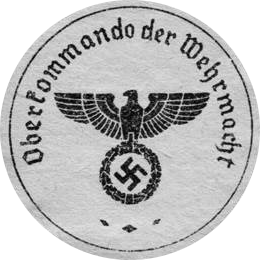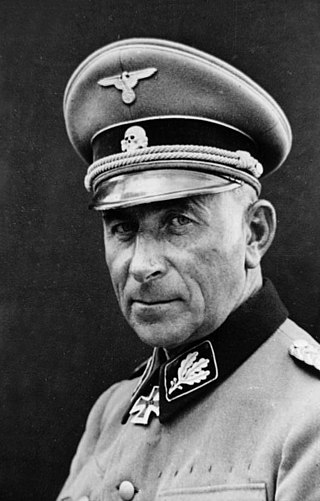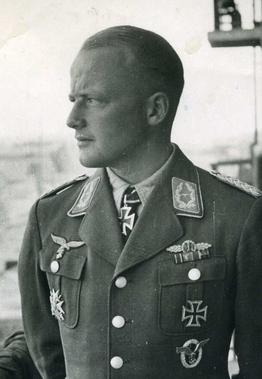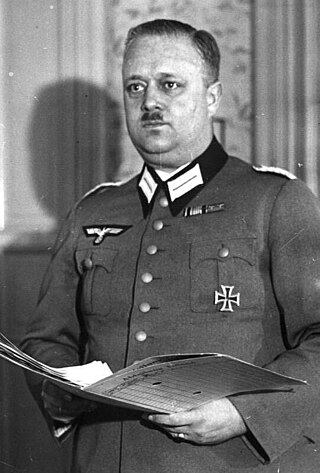
The Waffen-SS was the combat branch of the Nazi Party's paramilitary Schutzstaffel (SS) organisation. Its formations included men from Nazi Germany, along with volunteers and conscripts from both occupied and unoccupied lands.

The Oberkommando der Wehrmacht ; High Command of the Armed Forces) was the supreme military command and control office of Nazi Germany during World War II. Created in 1938, the OKW replaced the Reich Ministry of War and had oversight over the individual high commands of the country's armed forces: the army, navy, and air force.

Paul Hausser also known as Paul Falk after taking his maiden name post war was a German general and then a high-ranking commander in the Waffen-SS who played a key role in the post-war efforts by former members of the Waffen-SS to achieve historical and legal rehabilitation.

Non-Germans in the German armed forces during World War II were volunteers, conscripts and those otherwise induced to join who served in Nazi Germany's armed forces during World War II. In German war-time propaganda those who volunteered for service were referred to as Freiwillige ("volunteers"). At the same time, many non-Germans in the German armed forces were conscripts or recruited from prisoner-of-war camps.

During World War II, the German Wehrmacht committed systematic war crimes, including massacres, mass rape, looting, the exploitation of forced labor, the murder of three million Soviet prisoners of war, and participated in the extermination of Jews. While the Nazi Party's own SS forces was the organization most responsible for the genocidal killing of the Holocaust, the regular armed forces of the Wehrmacht committed many war crimes of their own, particularly on the Eastern Front.
HIAG was a lobby group and a denialist veterans' organisation founded by former high-ranking Waffen-SS personnel in West Germany in 1951. Its main objective was to achieve legal, economic, and historical rehabilitation of the Waffen-SS.

The German Army was the land forces component of the Wehrmacht, the regular Armed Forces of Nazi Germany, from 1935 until it effectively ceased to exist in 1945 and then was formally dissolved in August 1946. During World War II, a total of about 13.6 million soldiers served in the German Army. Army personnel were made up of volunteers and conscripts.

Wehrmachtbericht was the daily Wehrmacht High Command mass-media communiqué and a key component of Nazi propaganda during World War II. Produced by the Propaganda Department of the OKW, it covered Germany's military situation and was broadcast daily on the Reich Broadcasting Corporation of Nazi Germany. All broadcasts were authorized by the Reich Ministry of Propaganda under Joseph Goebbels. Despite the latter's attempts to temper excessive optimism, they often exaggerated the success of the German armed forces, the Wehrmacht, leading historian Aristotle Kallis to describe their tone as "triumphalist".
Herbert Bareuther was a World War II fighter ace from Nazi Germany. Bareuther was credited with having shot down a total of 55 enemy aircraft. All the victories he achieved were recorded over the Eastern Front.

Otto Dessloch was a German Luftwaffe general during World War II and recipient of the Knight's Cross of the Iron Cross with Oak Leaves of Nazi Germany.

The Wehrmacht were the unified armed forces of Nazi Germany from 1935 to 1945. It consisted of the Heer (army), the Kriegsmarine (navy) and the Luftwaffe. The designation "Wehrmacht" replaced the previously used term Reichswehr and was the manifestation of the Nazi regime's efforts to rearm Germany to a greater extent than the Treaty of Versailles permitted.
Max Liedtke was a German journalist and army officer. He was honoured as Righteous Among the Nations for his resistance against the "liquidation" of the entire Jewish population of the ghetto in Przemyśl in eastern Poland.

Ulrich Diesing was a German pilot in the Luftwaffe during World War II. He was a recipient of the Knight's Cross of the Iron Cross of Nazi Germany. On 17 April 1945, Ulrich Diesing was killed in an accident near Boizenburg, Nazi Germany. During his career he was credited with 15 aerial victories.

Hasso von Wedel was a German general who commanded the Wehrmacht Propaganda Troops during World War II. He was directly subordinate to the head of OKW Operations Staff, General Alfred Jodl. Wedel's Propaganda Department had control over the propaganda units and served to mediate between them and the Reich Propaganda Ministry of Joseph Goebbels.

Franz Kurowski was a German author of fiction and non-fiction who specialised in World War II topics. He is best known for producing apologist, revisionist and semi-fictional works on the history of the war, including the popular English-language series Panzer Aces and Infantry Aces.
The SS Education Office (SS-Schulungsamt) was one of the Nazi organizations responsible for the ideological indoctrination of members of the SS. The office operated initially under the jurisdiction of the Reich Race and Settlement Office (RuSHA) but was later subordinated to the SS Main Office (SS-Hauptamt).
The Waffen-SS, the combat branch of the paramilitary SS organisation of Nazi Germany, is often portrayed uncritically or admiringly in popular culture.
Army Group Rear Area Command was an area of military jurisdiction behind each of the three Wehrmacht army groups from 1941, the German invasion of the Soviet Union in Operation Barbarossa, through 1944 when the pre-war territories of the Soviet Union were recovered. The areas were sites of mass murder during the Holocaust and other crimes against humanity targeting the civilian population.

The Minsk Trial was a war crimes trial held in front of a Soviet military tribunal in 1946 in Minsk, the capital of Soviet Belarus. Defendants included German military, police, and SS officials who were responsible for implementing the occupational policies in Belarus during the German–Soviet War of 1941–45.
Daniel Uziel is an Israeli historian and head of photographic collections at Yad Vashem. His doctoral thesis was on the Wehrmacht propaganda corps and was accepted in 2001 by Hebrew University in Jerusalem.













